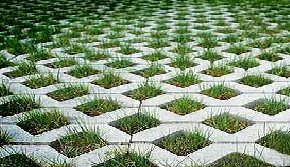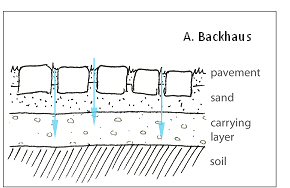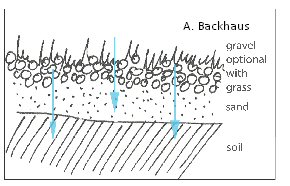Permeable surfacing
Like other forms of surfacing, permeable pavements provide a horizontal surface suitable for walking or driving on, but also allow rainwater to seep through. Permeable pavements are not intended to receive water from adjoining areas, but run-off from the surface itself is reduced. The infiltration capacity of the surfacing depends partly on its design and partly on the hydraulic capacity of the carrying layer and the soil underneath and alongside. Some permeable pavements are built with an attenuation volume below the pavement.
Grass pavings combine the excellent infiltration and growth properties of grass with greater durability and load-bearing capacity than ordinary grass (figures 1 and 2). They come as concrete flagstones with holes for grass to grow or a grass paving grid with a honeycomb structure. The holes are filled to just below the edge with a suitable growth medium such as a sand-humus mix, and grass is sown. The holes must be filled right up to the edge to protect the grass growth points. The surface of grass paving grids can allow up to 90% of the water to infiltrate.

Figure 1: Grass surface in concrete (Photo from http://eastcoastgreen.info/images/beautiful-grassy-pavers.jpg)

Figure 2: Infiltration between concrete blocks (Sketch A. Backhaus)
Gravel surfaces are porous and allow rainwater to infiltrate the underlying soil (figures 3 and 4). Washed gravel, that is, gravel with a low clay content, is most suitable. Gravel can be combined with grass to create a surface known as gravel lawn – or with a few attractive herbaceous plants.
Figure 3: Gravel lawn (Photo: A. Backhaus)

Figure 4: Infiltration through gravel (A. Backhaus)

